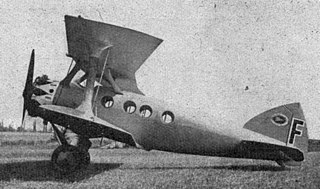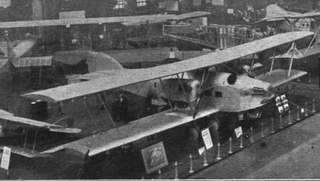| Potez X | |
|---|---|
 | |
| Role | General purpose colonial transport aircraft |
| National origin | France |
| Manufacturer | Potez |
| First flight | 1922 |
| Variants | * Potez XVIII |
The Potez X was a French 1920s general-purpose colonial transport aircraft designed and built by Potez.
| Potez X | |
|---|---|
 | |
| Role | General purpose colonial transport aircraft |
| National origin | France |
| Manufacturer | Potez |
| First flight | 1922 |
| Variants | * Potez XVIII |
The Potez X was a French 1920s general-purpose colonial transport aircraft designed and built by Potez.
The Potez X was a three-engined biplane with a fixed nosewheel landing gear supplemented with a tailskid. [1] The first variant was the Potez X A which was powered by three 140 hp (104 kW) Hispano-Suiza 8Aa piston engines, two strut-mounted between the upper and lower wings and one nose-mounted. [1] It had an enclosed cabin for 10 passengers with the pilot in an open cockpit behind the cabin. [1] Later the engines were changed to more powerful Hispano-Suiza 8Ab versions. [1] Two other variants were built with 280 hp (209 kW) Hispano-Suiza 8Bec engines, the X B was a military variant and the X C a commercial variant. [1]
The Potez X formed the basis of two similar airliners in the Potez XVIII and Potez XXII. [2] [3]

General characteristics
Performance

Potez 25 was a French twin-seat, single-engine biplane designed during the 1920s. A multi-purpose fighter-bomber, it was designed as a line aircraft and used in a variety of roles, including fighter and escort missions, tactical bombing and reconnaissance missions. In the late 1920s and early 1930s, Potez 25 was the standard multi-purpose aircraft of over 20 air forces, including French, Polish and American. It was also popular among private operators, notably mail transport companies.

The Blériot Bl-115 was a French biplane airliner of the 1920s, best remembered for the part it played in the French exploration of Africa. For its day, it was a large aircraft, mounting one pair of engines on the upper wing and one pair on the lower. First flying on 9 May 1923, the prototype crashed on 23 June, killing its pilot, Jean Casale.

The Blériot 127 was a French bomber aircraft of the 1920s and 1930s, developed from the Blériot 117 escort fighter. It was a large monoplane of conventional configuration that featured open gunner's positions in its nose and at the rear of its two underwing engine nacelles. The wing airfoil was of sufficient thickness that these latter positions could be accessed from the fuselage in flight.

The Blériot-SPAD S.56 was a family of French airliners developed in the 1920s as various refinements of the S.33 design. All S.56 versions shared two new features: the first was a newly designed, all-metal wing, replacing the wooden wing of earlier related designs and the second was a redesigned passenger cabin, replacing the S.33's four single seats in a row with two rows of double seats. A second access door was also added.

The CAMS 46 was a flying boat trainer aircraft built in France in the mid-1920s, essentially an updated version of the CAMS 30 that had flown in 1922. While retaining that aircraft's basic form, CAMS offered the French Navy two new versions with aerodynamic refinements over the earlier aircraft: the CAMS 46 E primary trainer, and the CAMS 46 ET intermediate trainer. Only the latter was selected for production and was built in quantity to supply one escadrille at the Naval training station at Hourtin.

The Nieuport-Delage NiD.62 was a French sesquiplane fighter from the early 1930s. This machine was a descendant of a long line of Nieuport-Delage fighters that were designed and built during the years immediately after World War I. The NiD.62 was built in 1931 as a fighter for the Armée de l'Air. It served until the late 1930s, when it was replaced by more modern monoplane fighters. By the time of the outbreak of World War II in September 1939, all of the NiD.62s had been withdrawn from front-line fighter escadrilles but were used as trainers in French flight schools. A few aircraft were employed as target tugs. After the French German Armistice and German occupation of North and West part of France in June 1940, the German Luftwaffe had no interest in the NiD.62s and they were scrapped. None survived the war.

Potez 62 was a French twin-engine civil airliner, designed by Henry Potez in 1934.

The Farman F.120 and its derivatives were a family of multi-engine airliners and bombers of the 1920s built by the Farman Aviation Works in France.

The Morane-Saulnier MS.230 aircraft was the main elementary trainer for the French Armée de l'Air throughout the 1930s. Almost all French pilots flying for the Armée de l'Air at the outbreak of World War II had had their earliest flight training in this machine. It was the equivalent of the Stearman trainer in the United States air services and the de Havilland Tiger Moth in the British Royal Air Force.

The Farman F.200 was a civil utility aircraft produced in France in the 1930s. Derived from the F.190, it featured a revised fuselage that did away with its predecessor's enclosed cabin. Instead, it was a parasol-wing monoplane with open cockpits in tandem for the pilot and one or two passengers. Intended primarily as a trainer, it was also marketed as being suitable as a photographic platform or a mail plane.

The Farman F.300 and F.310 were airliners built in France in the early 1930s. They were high-wing strut braced monoplanes with fixed tailskid undercarriage with a trimotor layout popular with several manufacturers of the time. The cockpit and passenger compartment were fully enclosed. Most saw service in Farman's own airline, whose twelve F.300 variants made up half its fleet in 1931.

The Morane-Saulnier Vanneau is a two-seat basic trainer built in France by Morane-Saulnier and ordered by the French Air Force.

The Lioré et Olivier H-190 was a flying boat airliner produced in France in the late 1920s. Conventional for its day, it was a single-bay biplane with un-staggered wings, its single engine mounted tractor-fashion underneath the upper wing and supported on struts in the interplane gap. Early examples had the pilot's open cockpit located aft of the wing, but this was later relocated forward of the wing.
The Farman F.150 was a 1920s French twin-engined biplane designed by Farman as a day bomber.

The Potez XVIII was a French airliner from the early 1920s, a three-engine biplane carrying up to twelve passengers.

The Blériot-SPAD S.91 was a French light-weight fighter aircraft. It would be later developed into the Blériot-SPAD S.510, the last biplane produced by the French aeronautic industries.

The SAB AB-80 was a French bomber built in 1934 by the Société Aérienne Bordelaise (SAB) in Bordeaux.

The Hanriot H.34 was a basic trainer designed in France in 1924 which did not reach production. It was a parasol wing aircraft, seating two in tandem.

The Potez XIX was a prototype French night bomber built by Potez in the 1920s.
The Romano R.120 was a twin-engine 4-seat bomber aircraft designed by Etienne Romano in the 1930s.
| Wikimedia Commons has media related to Potez X . |